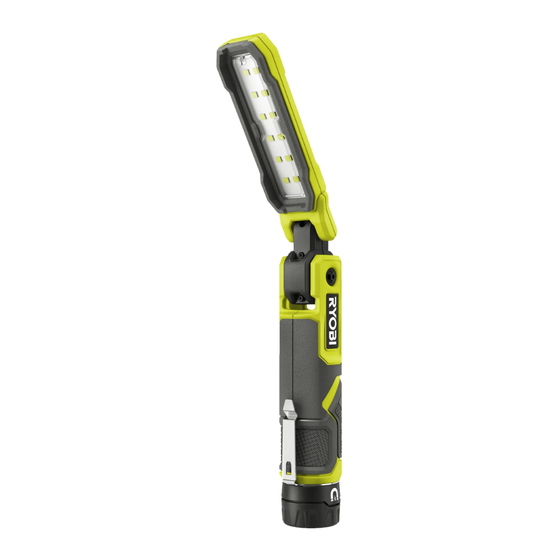
Advertisement
Quick Links
ORIGINAL INSTRUCTIONS
USB Lithium Inspection Light
RIL4
IMPORTANT!
It is essential that you read the instructions
in this manual before assembling, operating,
and maintaining the product.
Subject to technical modifications.
Safety, performance, and dependability have
been given top priority in the design of your
inspection light.
INTENDED USE
The light is intended for general illumination.
With the magnetic function, the product can be
attached to horizontal steel surfaces.
Do not use the product for any other purpose.
Use of the product for operations different from
intended could result in a hazardous situation.
LIGHT SAFETY WARNINGS
■
The light source of this luminaire is not
replaceable.
When
the
light
reaches its end of life the whole luminaire
shall be replaced.
■
Use only with recommended battery pack
and charger. Any attempt to use another
battery pack will cause damage to the
product and could possibly explode, cause
a fire, or personal injury.
■
Do not disassemble the product.
■
If wrapped or in contact with fabrics, the
lens can produce sufficient heat to melt
some fabrics. To avoid serious personal
injury, never allow the lens to come in
contact with anything.
■
Do not place the product or battery pack
near fire or heat. This will reduce the risk
of explosion and possible injury.
■
Remove the battery pack or disconnect
the mains power before starting any work
on the product.
■
Do not store the product in a damp or
wet location, or in a location where the
temperature may reach or exceed 40°C.
For example, inside sheds, vehicles, or
metal buildings in the summer.
■
Do not direct the light beam at persons
or animals and do not stare into the light
beam yourself (not even from a distance).
Staring into the light beam may result in
serious injury or vision loss.
■
Use the magnets to mount the product
on 22-gauge low carbon steel surface.
Minimum thickness: 0.6 mm.
BATTERY SAFETY WARNINGS
■
To reduce the risk of fire, personal injury,
and product damage due to a short circuit,
never immerse your tool, battery pack, or
charger in fluid or allow fluid to flow inside
them. Corrosive or conductive fluids, such
as seawater, certain industrial chemicals,
and bleach or bleach-containing products,
etc., can cause a short circuit.
TRANSPORTING LITHIUM BATTERIES
Transport the battery in accordance with local
and national provisions and regulations.
Follow all special requirements on packaging
and labelling when transporting batteries by a
third party. Ensure that no batteries can come
in contact with other batteries or conductive
materials while in transport by protecting
exposed connectors with insulating, non-
conductive caps or tape. Do not transport
batteries that are cracked or leaking. Check
with the forwarding company for further advice.
source
MAINTENANCE
■
Use only original accessories and spare
parts. Should components that have not
been described need to be replaced,
please contact an authorised service
centre. All repairs should be performed by
an authorised service centre.
■
Avoid using solvents when cleaning
plastic parts. Most plastics are susceptible
to various types of commercial solvents
and may be damaged by their use. Use
clean cloths to remove dirt, carbon dust,
etc.
■
Do not at any time let brake fluids,
gasoline,
petroleum-based
penetrating oils, etc., come in contact with
plastic parts. Chemicals can damage,
weaken or destroy plastic which may
result in serious personal injury.
SYMBOLS
Direct current
Regulatory Compliance Mark
(RCM). Product meets applicable
regulatory requirements.
Please
carefully
product.
Do not stare at the operating light
source.
Class III protection
Do not dispose of waste
batteries, waste electrical
and electronic equipment as
unsorted municipal waste. Waste
batteries and waste electrical
and electronic equipment must
be collected separately. Waste
batteries, waste accumulators,
and light sources have to be
removed from the equipment.
Check with your local authority
or retailer for recycling advice
and collection point. According
to local regulations, retailers
may have an obligation to
take back waste batteries and
waste electrical and electronic
equipment free of charge. Your
contribution to the reuse and
recycling of waste batteries and
waste electrical and electronic
equipment helps to reduce the
demand of raw materials. Waste
batteries, in particular containing
lithium, and waste electrical
and electronic equipment
contain valuable and recyclable
materials, which can adversely
impact the environment and the
human health if not disposed of
in an environmentally compatible
manner. Delete personal data
from waste equipment, if any.
products,
SYMBOLS IN THIS MANUAL
Note
Parts or accessories sold
separately
Pivoting joint
On/Off button
Magnetic battery cap
Belt clip
180° Pivoting light head
USB charging cable
Battery
Operator's manual
USB power adaptor
read
the
instructions
before
starting
the
Advertisement

Summary of Contents for Ryobi RIL4
- Page 1 Please read instructions on 22-gauge low carbon steel surface. carefully before starting Minimum thickness: 0.6 mm. RIL4 product. BATTERY SAFETY WARNINGS Do not stare at the operating light IMPORTANT! ■ To reduce the risk of fire, personal injury, source. It is essential that you read the instructions...
- Page 2 0.17 kg 31 Gilby Road, Mount Waverley, VIC 3149 Melbourne, Australia Techtronic Industries N.Z. Limited Unit C, 70 Business Parade South, Highbrook, Auckland 2013, New Zealand RYOBI is a trade mark of Ryobi Limited, and is used under license. 20230919v1...
















Need help?
Do you have a question about the RIL4 and is the answer not in the manual?
Questions and answers